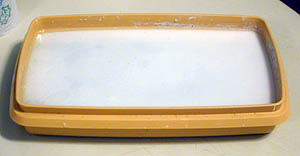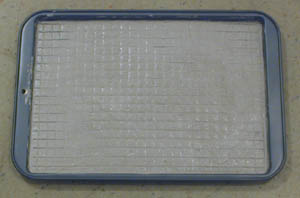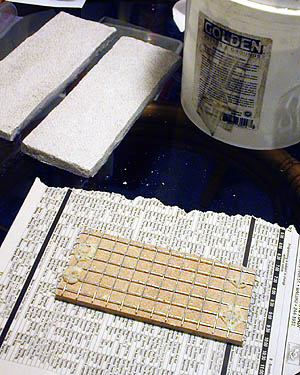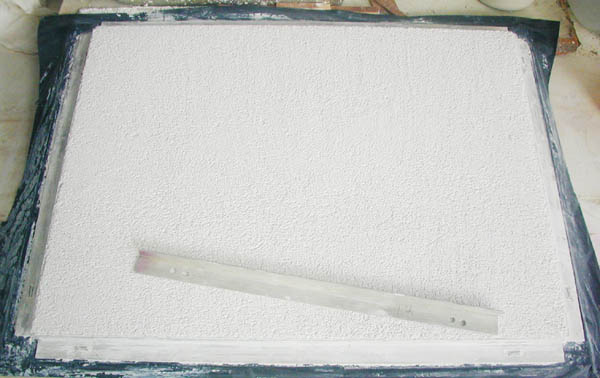| The smaller plastic mold has 1/2 sand, 1/2 marble meal and one pit lime. Alum and casein, with two layers of galvanized 1/2" square wire is inside it. I floated enough very rich lime milk on top to level the mortar and let it set awhile, then pored off the limewater and carbonate crust. That might make the white surface I'm looking for. I guess that would be like coating a ready wall with lime milk first.
Day 2, It still wasn't dry and was cracking, this isn't going to work. The larger mold made of Teflon has the same except it only has one wire layer and is waiting for the intonaco. I put it into a 200 degree oven, that seemed to work but it's not the way to go. Both of these tests failed.   This is another idea I'm trying. I got a 1/4 inch composite board, cut the 1/2 inch square cage wire a half inch larger than the board and bent it over the edge, glued the wire to the board with Gorilla glue, sprayed the glue with water to make it expand. When it was dry I painted it all with an acrylic mortar glue and put a 1/4 inch brown coat of 1/2 sand, 1/2 pit lime and pushed it into the wire spaces so it wouldn't have air in it. This worked great and was very light.  The next fresco board uses metal lathe and cement glue in the mortar. Later test showed me not to use casein, glue or cement additives.
Ok.. I got it now. Two months later.. 5-11-4
I put a 1/8 inch plywood cut to the final size on inside at the bottom of the form. That is to reduce the thickness of the fresco so the form can still be used for the laying the intonaco. Plastic was on the bottom and mineral oil was on the sides of the form. The rough coat is 32 oz. of white cement plus a cap full of cement binder, 16 oz. large sand, 16 oz. of medium grit sand, 1:2. This made a rough coat 3/8" of an inch thick. In the middle of the mortar I put a sheet of metal lath. This dried for three days, I soaked it well and spread a layer of lime mortar 1:1 with large sand only the thickness of the sand and let it dry. Now I am not limited to the 12x12 of ceramic tiles.
I saw a really interesting fragmented mural. It looked very old and parts of the fresco looked missing. How it was made is the interesting part. Burlap was glued to the wall with rabbit skin glue, a rough coat was added, dried, rewet with lime water, than the intonaco was applied and painted. I haven't tried it but I like the idea. Make a Mold
 |
